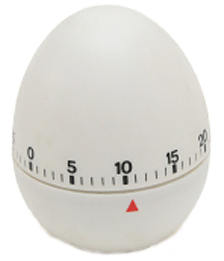Pimer2 - An improved visual timer for your Raspberry Pi
We recommend using the new driver free based scripts for LedBorg.
The new driver free examples can be found here, the installation can be found here.
We had a simple Raspberry Pi egg timer before, Pimer, but what it lacked was a way of seeing how long is left to go.
We figured it would be good to use LedBorg more like a proper egg timer and give an indication of how long is left to go.

We decided to use our previous colour coding to represent how long we have waited:
| <=11% | <=22% | <=33% | <=44% | <56% | <67% | <78% | <89% | >=89% |
The improved version is Pimer2.py, a Python script which takes a time in seconds and counts down in colours until time is up.
There are a few variables in the scripts you may wish to set to change options:
coloursDone- Line 19, colours to cycle through when done, we have gone for flashing red but the sequence could be anythingdoneDelay- Line 20, time in seconds between changes when done, make it flash faster or slower
Here's the code, you can download the Pimer2 script file as text here
Save the text file on your pi as Pimer2.py
Make the script executable using
chmod +x Pimer2.pyand run using
./Pimer2.py time_to_measure
#!/usr/bin/env python
# coding: latin-1
# Import library functions we need
import time
import sys
import threading
# Make a function to set the LedBorg colour
def SetColour(colour):
LedBorg=open('/dev/ledborg','w')
LedBorg.write(colour)
LedBorg.close()
# Set up our temperature chart, from ages to nearly done
colours = ['002', '012', '022', '021', '020', '120', '220', '210', '200']
# Setup for colour changing
coloursDone = ['000', '200'] # Colour cycle when done
doneDelay = 0.5 # Time between updates in seconds when done
# Class for the user interaction thread
class WaitForUser(threading.Thread):
# The code which will be run when the thread is started
def run(self):
global waiting
# Wait for the user to press enter
tempString = raw_input()
# Set the waiting flag and finish
waiting = False
# Get user input
if len(sys.argv) > 1:
try:
delay = float(sys.argv[1])
except ValueError:
# Not a valid number
print '"%s" is not a number!' % (sys.argv[1])
print 'Usage: %s time_in_seconds' % (sys.argv[0])
sys.exit()
else:
print 'Usage: %s time_in_seconds' % (sys.argv[0])
sys.exit()
# Setup status flags
global waiting
waiting = True
try:
# Make sure we are using floats
doneDelay = float(doneDelay)
delay = float(delay)
# Calculate the time period of each colour segment
segmentDelay = delay / float(len(colours))
# Display each colour in turn
for colour in colours:
# Set the relevant colour
SetColour(colour)
# Wait a while
time.sleep(segmentDelay)
# Setup a thread to wait for user input
print "Time's up!"
print 'Press ENTER to stop the timer'
WaitForUser().start()
# Cycle the LedBorg through the done sequence until stopped by the user
while waiting:
for colour in coloursDone:
# Set the relevant colour
SetColour(colour)
# Wait a while
time.sleep(doneDelay)
# Finish early if we have been stopped
if not waiting:
break
# Turn the LedBorg off
SetColour('000')
except KeyboardInterrupt:
# CTRL+C exit, turn off the LedBorg
print 'Terminated'
SetColour('000')


